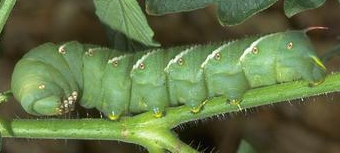By Michelle Ramsey, Butte County Master Gardener, June 28, 2013
If something is eating your tomato plants or your eggplants, hornworms may very well be the culprit.
Two common species of hornworms seen in the garden are the Tomato Hornworm (Manduca quinquemaculata) and the Tobacco Hornworm (Manduca sexta). They can be differentiated by how many white stripes the larvae have on each side of their bodies. Tobacco hornworm larvae have 7 diagonal stripes on each side, while the tomato hornworm larvae have 8 chevron-shaped stripes. Mature hornworm larvae can be very large, up to 4 inches long (they will most likely be the largest “caterpillar” you’ll see in your garden). Hornworms feed on blossoms, leaves and fruit and are particularly known to cause damage to tomatoes and eggplants. Damage to plants typically occurs in mid-summer (but may also be seen in late summer). In their larval stage, hornworms are green caterpillars often seen hanging upside down on the plants. They have a “horn” at the rear end of their body. In the early summer, hornworm eggs (laid singly on leaves), hatch into larva. The larvae feed on leaves for 3-4 weeks and then burrow into the ground to pupate. The pupa over-winter in the ground and then emerge as adult moths. Adult hornworm moths are strong fliers with a wingspan of up to 5 inches.
The larval form of the hornworm is the only stage that causes damage to your plants. Hornworms can be hard to find as their green coloring provides a nice camouflage for them amidst the tomato plant leaves. Foliage damage (and possibly some damage or scarring of fruit) and large droppings on the dirt under the plants are indications that hornworms are present in the garden. When the plant is shaken gently hornworms will sometimes make a clicking sound which can help you locate the intruder. Natural enemies of hornworms are the Trichogramma parasitic wasp which lays eggs in the hornworm eggs and the Hyposoter exiguae parasitic wasp which infests the hornworm larvae as a parasite.
The most common methods of hornworm management are hand-picking them off plants and/or snipping them with shears. However, if the hornworm infestation is out of control, an organic spray (Bacillus thuringiensis or Spinosad) may be applied. These sprays are effective against smaller hornworm larvae but will not destroy the natural enemies of the hornworms. Crop rotation and disking (breaking up and turning over the soil) after harvest destroys pupae in the soil, and will help prevent emergence and a repeat of the hornworm life cycle in your garden the following year.
For additional information visit:
http://www.ipm.ucdavis.edu/PMG/r783301111.html
